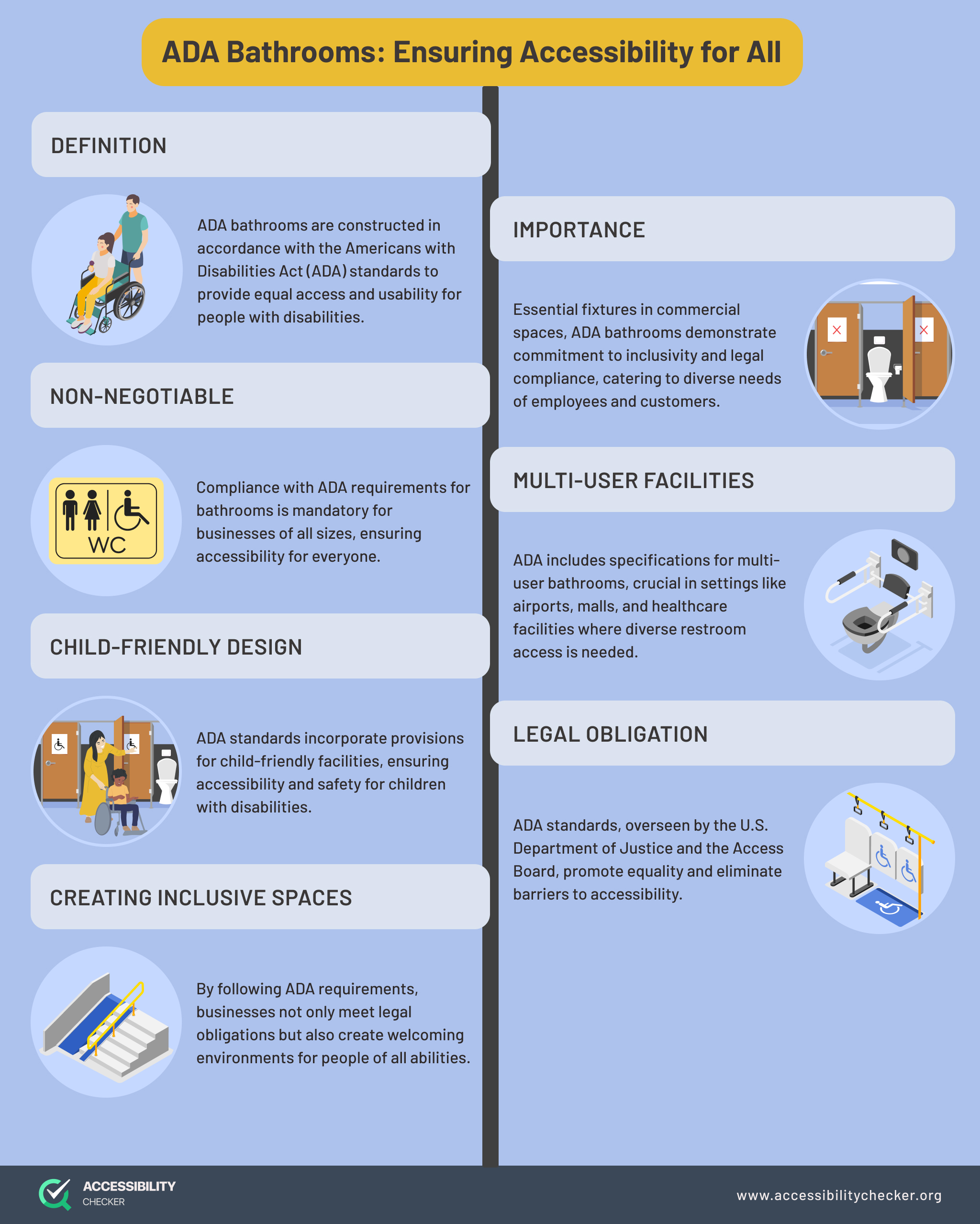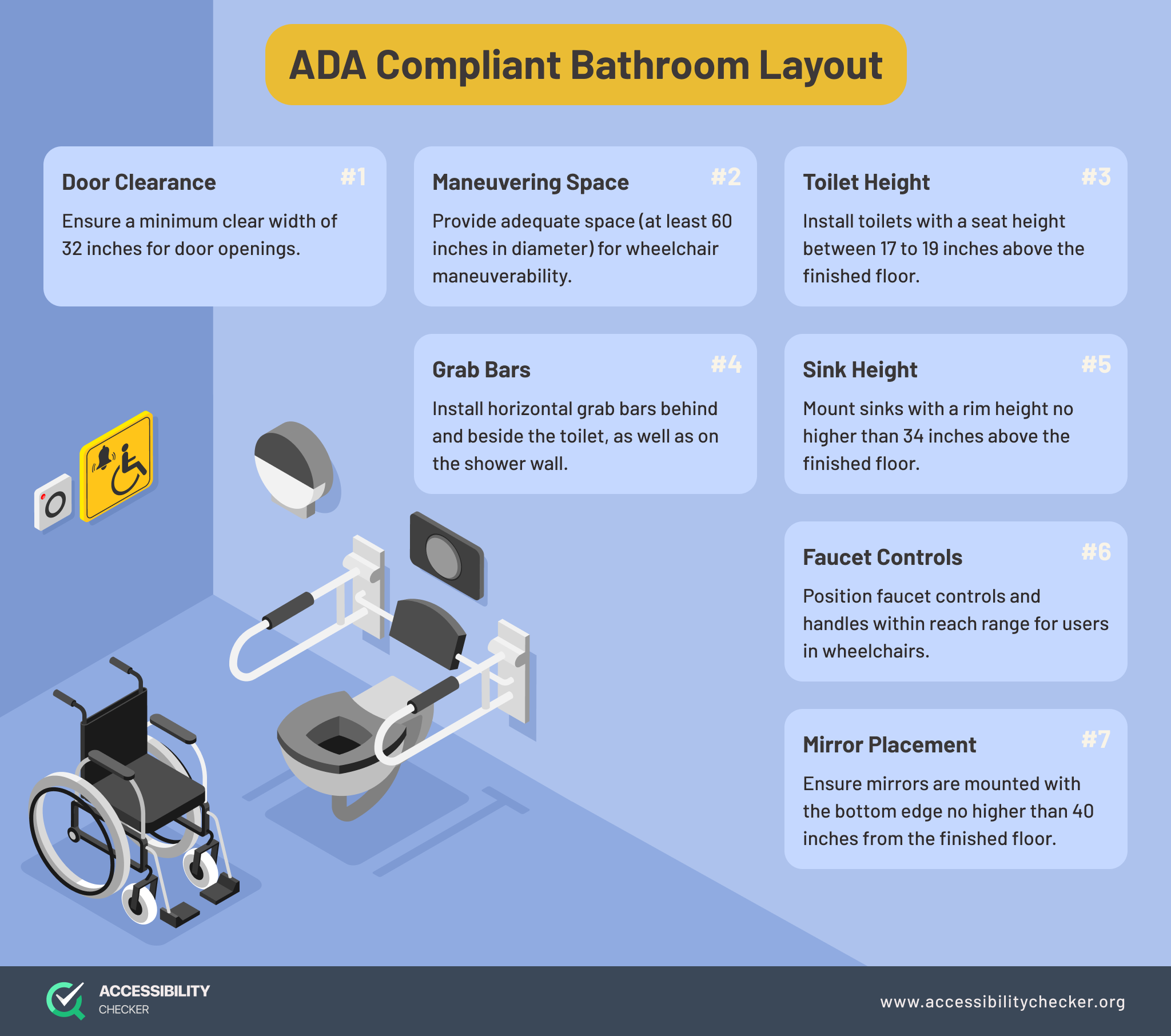ADA Requirements for Bathrooms: Standards and Compliance
When it comes to ensuring accessibility for all people, particularly those with disabilities, ADA-compliant bathrooms play an important role.
An ADA bathroom is a restroom that’s constructed in accordance with the standards outlined in the Americans with Disabilities Act (ADA). These bathrooms are designed to provide equal access and usability for people with disabilities, ensuring they can use restroom facilities independently and comfortably.
If you’re the owner of a commercial space, ADA-compliant bathrooms are essential fixtures. Not only are they mandated by law but also show your commitment to inclusivity and social responsibility. Businesses, regardless of size, must adhere to these standards to cater to the diverse needs of their employees and customers.
It doesn’t matter if you run a small retail store or large corporate offices, compliance with ADA requirements for bathrooms is non-negotiable.
Along with bathrooms designed for individual use, the ADA also includes multi-user bathrooms in its requirements. These bathrooms are designed to accommodate more than one person at a time.
These facilities are particularly important in settings like airports, shopping malls, educational institutions, and healthcare facilities, where a diverse range of people may require restroom access at the same time.
ADA requirements for bathrooms also extend beyond adults to include provisions for children. Recognizing the unique needs of young people, ADA standards incorporate specifications for child-friendly facilities, such as lower sinks, toilets, and grab bars, ensuring that children with disabilities can also use restroom facilities comfortably and safely.
The importance of complying with the latest ADA standards cannot be overstated. These guidelines have been carefully crafted to promote equality, dignity, and independence for the disabled community. ADA standards are implemented by the U.S. Department of Justice (DOJ) and the Access Board, with the primary goal being to eliminate barriers to accessibility and make public accommodations more inclusive.
By following ADA requirements for bathrooms, businesses not only fulfill their legal obligations but also create an environment that is welcoming and accommodating to people of all abilities.
What Are the ADA Requirements for Bathrooms?
If you own or are managing a commercial facility, there are some essential ADA requirements you need to meet when it comes to bathrooms.

Let’s unpack these in more detail now.
1. Toilets
Accessible toilets, or handicap-accessible toilets, are restrooms that are designed to accommodate disabled users. These toilets are constructed in accordance with specific guidelines outlined in the Americans with Disabilities Act (ADA) to ensure usability and accessibility for people with disabilities.
Accessible toilets benefit people with mobility impairments who rely on wheelchairs, walkers, or crutches, as well as those with temporary mobility issues. People with cognitive impairments will also benefit from the clear and intuitive layouts and fixtures.
Here are the key requirements for accessible toilets as outlined in the ADA:
- Toilet Seat Height: The height of an accessible toilet seat should be between 17 inches (43.18 cm) and 19 inches (48.26 cm) above the floor.
- Flush Controls: Flush controls should be mounted on the open side of the toilet and should not require tight grasping, pinching, or twisting to operate. Lever-style flush controls are recommended.
- Toilet Stall Dimensions: Toilet stalls should be at least 60 inches (152.4 cm) wide and have an outward-swinging door or no door at all to benefit wheelchair users.
In the case of toilets for children with disabilities, toilet seats designed for children should be between 10 (25.4 cm) to 12 inches (30.48 cm) in height.
2. Grab Bars
Grab bars are an essential part of accessible bathrooms and are designed to provide support and stability for people with motor disabilities, even if they’re temporary. These bars are typically installed near toilets, showers, and bathtubs to help people sit down, stand up, and maintain balance while using the bathroom.
Here are the key requirements for grab bars as outlined in the ADA:
- Height: Grab bars must be mounted between 33 inches (83.82 cm) and 36 inches (91.44 cm) above the floor.
- Diameter: Grab bars should have a diameter between 1.25 inches (3.18 cm) and 1.5 inches (3.81 cm) to provide a comfortable grip.
- Clearance: Grab bars must have a clearance of 1.5 inches (3.81 cm) from the wall to allow for a firm grasp.
Length and Location
- For toilets: A horizontal grab bar must be installed on the side wall nearest the toilet and have a minimum length of 42 inches (106.68 cm) and extend at least 12 inches (30.48 cm) from the rear wall.
- For showers and bathtubs: Grab bars must be installed on at least one wall of the shower or bathtub, with a length of at least 24 inches (60.96 cm) and positioned between 33 inches (83.82 cm) and 36 inches (91.44 cm) above the floor.
When it comes to children’s bathrooms, grab bars should be installed at lower heights and should have a smaller diameter. These specifications are generally adjusted according to the age of the child.
3. Sinks
Accessible sinks are fixtures designed to accommodate disabled users with permanent and temporary mobility disabilities.
Lever-operated faucets and easily accessible controls may also benefit people with dexterity issues by reducing the need for precise hand movements, while people with cognitive impairments benefit from the simple and straightforward design.
Here are the key requirements for sinks as outlined in the ADA. It should be noted that these requirements should be reduced when designing accessible bathrooms for children.
- Height: The rim or counter of an accessible sink should be no higher than 34 inches (86.36 cm) above the floor to accommodate wheelchair users.
- Clearance: In terms of clearance, there needs to be a minimum of 29 inches (73.66 cm) of clearance underneath the sink to accommodate a wheelchair user’s knees and provide space for maneuvering.
- Depth: The depth of an accessible sink should be no more than 6.5 inches (16.51 cm) to ensure that people with limited reach can easily access the faucet and controls.
- Faucet Controls: Faucet controls should be lever-operated or sensor-activated to eliminate the need for grasping and twisting.
4. Signage
For a bathroom to be deemed accessible, appropriate signage is required. Signage should provide clear and comprehensive information about restroom facilities in a format that is accessible to people with disabilities.
Tactile signage with raised characters and Braille allows people with visual impairments to navigate and locate bathrooms more easily, while clear and simple signage aids people with cognitive impairments.
Well-placed signage with clear directional information also helps people with mobility impairments navigate large or complex facilities to access restroom facilities more conveniently.
When adding accessible bathroom signage in your facility, keep the following ADA requirements in mind:
- Placement and Location: Signs identifying accessible bathrooms must be mounted on the latch side of the restroom door, either adjacent to or on the door itself. It shouldn’t be higher than 60 inches (152.4 cm) above the floor to ensure visibility and accessibility for all users.
- Visual Elements: Signs must have high color contrast between the background and characters. The characters should also be in a sans-serif font and at least 5/8 inch (1.47 cm) high for tactile characters and 3/4 inch high for visual characters.
- Tactile Elements: Signs must include tactile characters and Braille to assist people with visual impairments in identifying and reading the signage.
- Pictograms: Where pictograms are used to convey information, they must be clear and comprehensible for all users.
- Mounting and Installation: Signs must be securely mounted and installed using specified hardware to ensure durability and stability over time.
5. Clear Floor Space
Clear floor space refers to the unobstructed area within a bathroom that allows people with disabilities to maneuver safely and comfortably.
This space is essential for accommodating mobility aids such as wheelchairs, walkers, and scooters, as well as providing room for people to transfer to and from these devices.
Unobstructed floor space also allows people with visual impairments to move freely and safely, reducing the risk of tripping or falling.
When constructing accessible bathrooms, these are the floor space requirements that you need to meet to comply with ADA standards:
- Width: The ADA requires a minimum clear floor space width of 30 inches (76.2 cm) to accommodate the movement of wheelchairs and mobility aids.
- Depth: A minimum depth of 48 inches (121.92 cm) is required to provide adequate space for disabled users to turn and maneuver within the area.
- Height Clearance: Overhead obstructions such as light fixtures, shelves, or cabinets should not encroach into the clear floor space.
What are the ADA Requirements for Multi-User Bathrooms?
The Americans with Disabilities Act (ADA) provides specific requirements for multi-user bathrooms and encompasses various elements.
Wheelchair-Accessible Stall
At least one wheelchair-accessible stall is required in multi-user bathrooms. The stall must have a minimum width of 60 inches (152.4 cm) and a depth of 56 inches (142.24 cm) to allow wheelchair users to maneuver more comfortably.
The doorway should have a minimum width of 32 inches (81.28 cm) and grab bars must be installed at specific heights and locations to assist with transfers and provide support. Grab bars should be between 33-36 inches (83.82 – 91.44 cm) above the floor, with at least 42 inches (106.68 cm) in length along the rear wall and 54 inches (137.16 cm) in length along the side wall.
Changes for Different Age Groups
- Ages 3-4: Consider reducing the height of grab bars and lowering the toilet seat height to accommodate young children.
- Ages 5-8: Maintain the recommended ADA measurements but ensure that the features are accessible to children of this age group.
- Ages 9-12: Similar to ages 5-8, ensure accessibility while considering the individual needs and preferences of children within this age range.
Compliant Urinal
When multiple urinals are installed in a multi-user bathroom, at least one must be compliant with ADA standards.
The rim of the urinal should be no higher than 17 inches (43.18 cm) above the floor to ensure accessibility for people using wheelchairs. The flush controls should also be mounted no higher than 44 inches (111.76 cm) above the floor to make them easy to reach.
Changes for Different Age Groups
- Ages 3-4: Consider installing a lower urinal to accommodate the height of young children.
- Ages 5-8: Standard ADA measurements are usually enough, but consideration should be given to the comfort and accessibility of children in this age group.
- Ages 9-12: Maintain the standard ADA measurements while ensuring that the urinal is accessible and usable for children of this age range.
Sinks and Mirrors
At least one sink and mirror combination per bathroom must be compliant with the latest ADA standards and located outside of a stall.
The sink should have a rim height of no more than 34 inches (86.36 cm) above the floor to accommodate wheelchair users. The knee clearance should be at least 27 inches (68.58 cm) high, 30 inches (76.2 cm) wide, and 19 inches (48.26 cm) deep to allow wheelchair users to approach the sink comfortably.
The mirror should be mounted with the bottom edge no higher than 40 inches (101.6 cm) above the floor to ensure visibility for shorter users.
Changes for Different Age Groups
- Ages 3-4: Lower the sink height and ensure that the knee clearance is suitable for young children.
- Ages 5-8: Similar to ages 3-4, ensure that the sink height and knee clearance are appropriate for children of this age group.
- Ages 9-12: The general ADA measurements are usually fine, but consider the requirements of children in this age group.
Ambulatory Accessible Stall
In multi-user bathrooms with six or more toilets and urinals, or where six or more stalls exist, at least one ambulatory accessible stall is required.
The ambulatory accessible stall should have a minimum width of 36 inches (91.44 cm) and a depth of 48 inches (121.92 cm) to aid people with mobility impairments. The doorway should have a minimum width of 32 inches (81.28 cm) to allow easy access. Lastly, grab bars must be installed to provide support and stability for people with motor disabilities.
Changes for Different Age Groups
- Ages 3-4: Ensure that the stall is accessible to young children by reducing the height of grab bars and ensuring that any other features are suitable for their height.
- Ages 5-8: Adhere to the standard ADA measurements, but consider the comfort and accessibility of children in this age group.
- Ages 9-12: Make any accommodations necessary for children in this age group.

In Closing
Bathrooms are an integral part of commercial facilities, which means they need to be accessible to all disabled employees, visitors, and customers.
By complying with the latest ADA bathroom guidelines, businesses can avoid unnecessary and costly lawsuits and ensure that everyone feels welcomed, included, and cared for.
FAQs
An ADA-compliant residential bathroom is one that caters to the needs of disabled family members and visitors. As per ADA guidelines for commercial facilities, residential bathrooms should also provide adequate clear floor space, a toilet and shower or bath with grab bars, sinks that are easy to use and reach, and slip-resistant flooring.
An ADA bathroom refers to a restroom facility that is designed and constructed in accordance with the accessibility standards outlined in the Americans with Disabilities Act (ADA). These standards cover various aspects of accessibility, including doorways, clear floor space, toilet stalls, sinks, grab bars, and more.
A handicapped bathroom is the same as an ADA bathroom, but the term is outdated and should be avoided.
Yes, ADA bathroom compliance is required by hotels in the United States as they are a type of public accommodation.
ADA compliance for hotels extends to all areas of the establishment, including guest rooms, common areas, and bathrooms. This includes ensuring that bathrooms within hotel rooms, as well as public restrooms in lobbies and dining areas, meet ADA accessibility standards.


